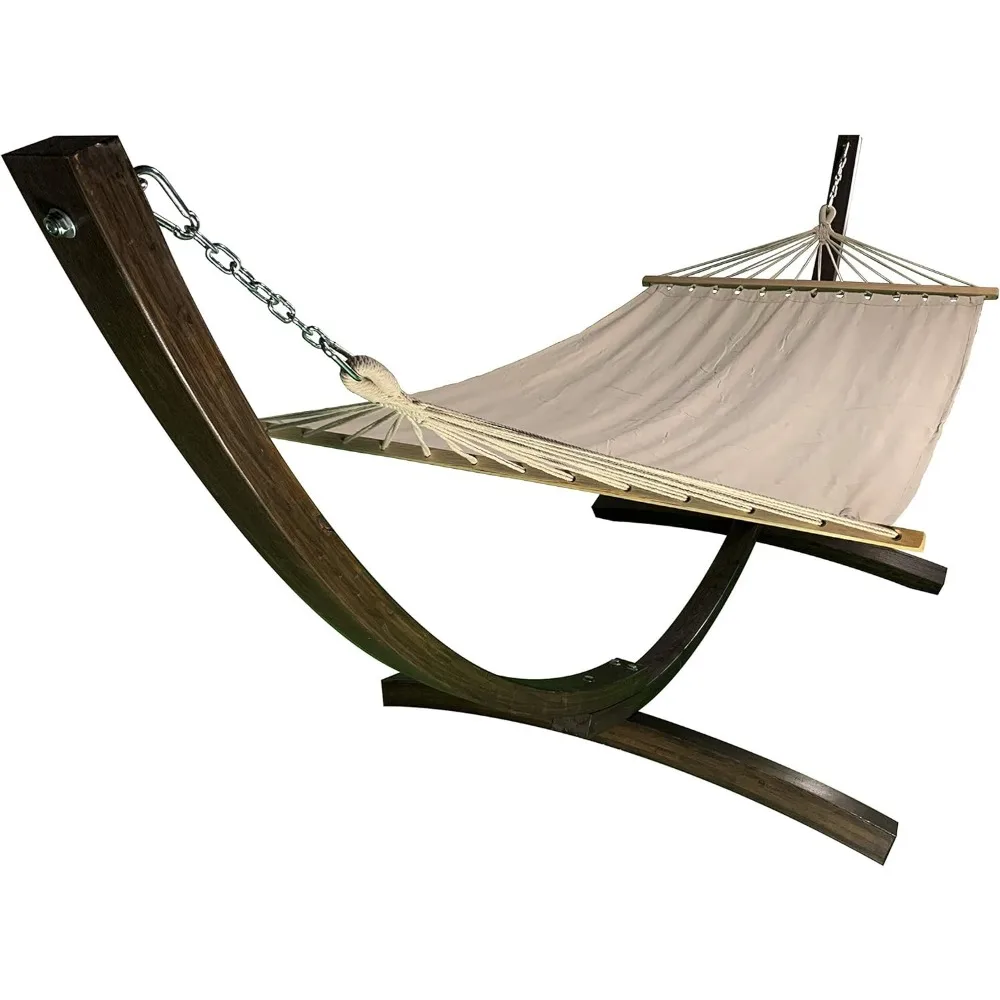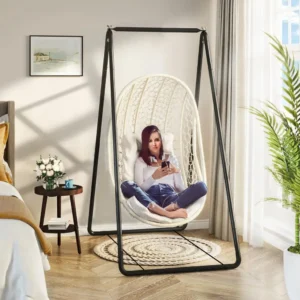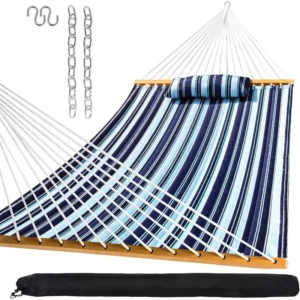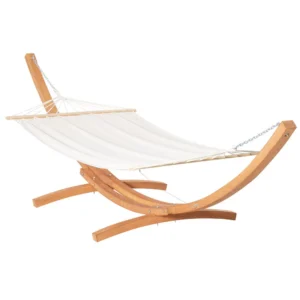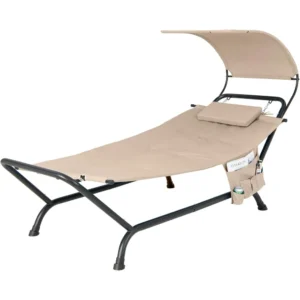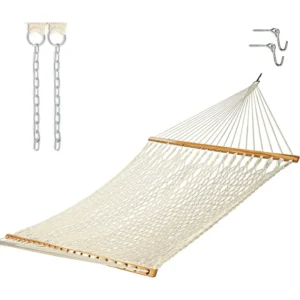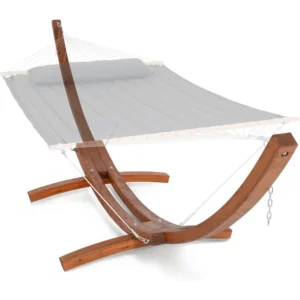What Makes Framed Spreader Bar Hammocks Unique? Understanding the Essentials
When it comes to outdoor relaxation, not all hammocks are created equal. Framed spreader bar hammocks represent the pinnacle of hammock innovation, combining the laid-back comfort of traditional designs with structural improvements that address common hammock complaints.
A framed spreader bar hammock features two key components that set it apart from other options:
- Integrated supporting frame: Unlike traditional hammocks that require trees or posts, these hammocks come with their own freestanding structure
- Spreader bars: Wooden or metal bars at each end that keep the hammock fabric taut and open
- Hammock bed: The fabric portion where you lie, typically made from cotton, polyester, or quilted materials
This combination creates something truly special – a hammock that offers exceptional stability without sacrificing comfort. The frame eliminates the need for attachment points while the spreader bars prevent the “cocoon effect” many people dislike about traditional hammocks.
Most framed spreader bar hammocks range from 10-15 feet (3-4.5 meters) in length, with hammock beds typically measuring 4-5 feet (1.2-1.5 meters) across. The frames come in various materials, with treated wood and powder-coated steel being the most common choices for durability.
Understanding the proper hammock placement for framed designs can help you maximize your relaxation experience. The unique construction of these hammocks opens up possibilities far beyond what traditional designs can offer.
Exploring different spreader bar hammock sets reveals the variety of styles and materials available to suit different outdoor spaces and personal preferences.
5 Core Benefits of Framed Spreader Bar Hammocks: Why They’re Worth the Investment
Framed spreader bar hammocks have gained popularity among discerning relaxation enthusiasts for good reason. These premium options offer distinctive advantages that address common pain points associated with traditional hammocks.
The five core benefits that make framed spreader bar hammocks stand out include:
- Enhanced stability and safety
- Superior flat-lay comfort
- Exceptional durability
- Unmatched placement convenience
- Designer aesthetic appeal
These benefits combine to create a relaxation experience that transcends what’s possible with standard hammocks. While the initial investment may be higher than basic options, the improved experience and extended lifespan make framed spreader bar hammocks a worthwhile consideration for serious comfort seekers.
Understanding how spreader bars affect hammock balance helps explain why these hammocks provide such a transformative experience compared to traditional designs.
Enhanced Stability and Safety: The Solid Foundation Advantage
The integrated frame of a spreader bar hammock provides a level of stability that simply can’t be matched by hanging hammocks. This fundamental difference transforms the entire hammock experience, particularly for those who’ve been hesitant to try hammocks due to safety concerns.
The stability advantages of framed spreader bar hammocks include:
- Eliminated tipping risk: The wide base and low center of gravity prevent the sudden flips that can occur with traditional spreader bar hammocks
- Secure entry and exit: The frame remains stable as you sit on the edge, making getting in and out of the hammock much easier, especially for older adults or those with mobility concerns
- Consistent weight distribution: The frame bears the weight evenly, preventing the hammock from sagging in the middle or becoming unbalanced
Most premium framed hammocks can safely support between 300-500 pounds (136-227 kg), making them suitable for couples or individuals of any size. This weight capacity far exceeds what’s typically recommended for hanging hammocks attached to trees or posts.
For those concerned about safety, understanding proper indoor and outdoor hammock safety can provide additional peace of mind. The structural support of a framed design eliminates many common hammock hazards right from the start.
Superior Comfort: The Perfect Flat Lay Experience
The distinctive comfort of a framed spreader bar hammock comes from its ability to maintain a flat, open lying surface. Unlike traditional hammocks that wrap around your body, the spreader bars keep the fabric taut, creating a more bed-like experience.
This flat lay design provides several comfort benefits:
- Elimination of the “cocooning” effect that some users find claustrophobic
- Even weight distribution that reduces pressure points along your back and sides
- Unobstructed views of your surroundings rather than just the fabric enclosing you
- Freedom to change positions easily – including side sleeping, which is nearly impossible in traditional hammocks
The typical lying area in a quality framed spreader bar hammock measures approximately 6.5 feet by 4.5 feet (2 meters by 1.4 meters), providing ample space to stretch out fully. Premium models often include additional padding, integrated pillows, and ergonomic contouring for enhanced comfort.
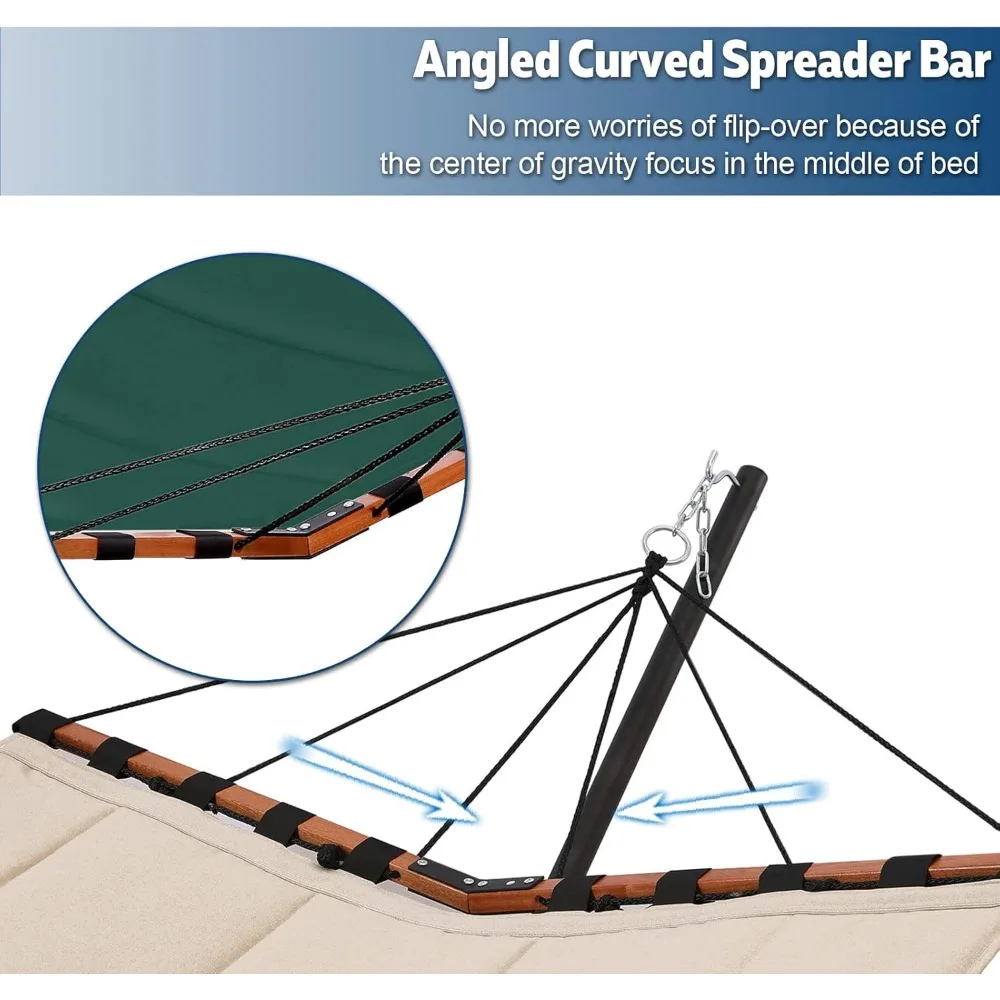
For those seeking the ultimate comfort experience, quilted fabric hammock sets combine the structural advantages of spreader bars with plush, padded surfaces that rival indoor furniture comfort.
Exceptional Durability: Built to Last Season After Season
One of the most compelling advantages of framed spreader bar hammocks is their outstanding durability. The integrated structure is engineered for longevity, protecting both the hammock fabric and the hammock’s overall integrity.
These durability enhancements include:
- Reduced fabric stress: The frame and spreader bars distribute weight evenly, preventing the fabric from stretching or tearing at attachment points
- Weather-resistant construction: Premium frames feature protective treatments like powder coating for metal or marine-grade finishes for wood
- Structural integrity: The rigid frame maintains proper alignment, preventing the twisting forces that often damage traditional hammocks
With proper care, a quality framed spreader bar hammock can last 7-10 years or more, compared to the 2-3 year lifespan typical of non-framed alternatives. This extended lifespan makes the initial investment much more economical when considered over time.
Understanding whether it’s okay to leave your hammock outside can help you maximize the longevity of your framed hammock. While these designs are built for durability, proper seasonal care ensures you’ll enjoy years of comfortable relaxation.
Unmatched Convenience: Place Your Hammock Anywhere
Perhaps the most liberating aspect of framed spreader bar hammocks is the complete freedom they provide in terms of placement. No longer constrained by the need for trees, posts, or mounting hardware, you can position your relaxation oasis wherever you desire.
This placement flexibility offers numerous advantages:
- No property modifications required (no drilling into walls or posts)
- No risk of damage to trees or structures
- Easy repositioning as needed for sun/shade or social gatherings
- Usable in spaces where traditional hammocks simply wouldn’t work
Perfect placement locations include:
– Apartment balconies without attachment points
– Center of open lawns
– Poolside areas
– Indoor spaces during colder months
– Vacation homes or rental properties
Most framed hammocks can be assembled in 15-30 minutes with basic tools, and once set up, they can be moved (with some effort) to different locations. The typical footprint requires about 12-15 feet (3.7-4.6 meters) of linear space and about 4-5 feet (1.2-1.5 meters) of width.
Discovering the best indoor and outdoor hammock locations can help you maximize the convenience of your framed hammock, taking advantage of its unique placement flexibility.
Designer Aesthetic Appeal: Elevating Your Outdoor Space
Beyond practical benefits, framed spreader bar hammocks serve as stunning focal points that enhance the visual appeal of any outdoor space. Unlike utilitarian hanging hammocks, these freestanding pieces function as legitimate furniture, adding architectural interest and style to your setting.
The aesthetic advantages include:
- Statement design that creates a designated relaxation zone
- Sculptural frames that add visual interest even when the hammock isn’t in use
- Premium materials that complement existing outdoor furniture
- Professional appearance that enhances the perceived value of your outdoor living area
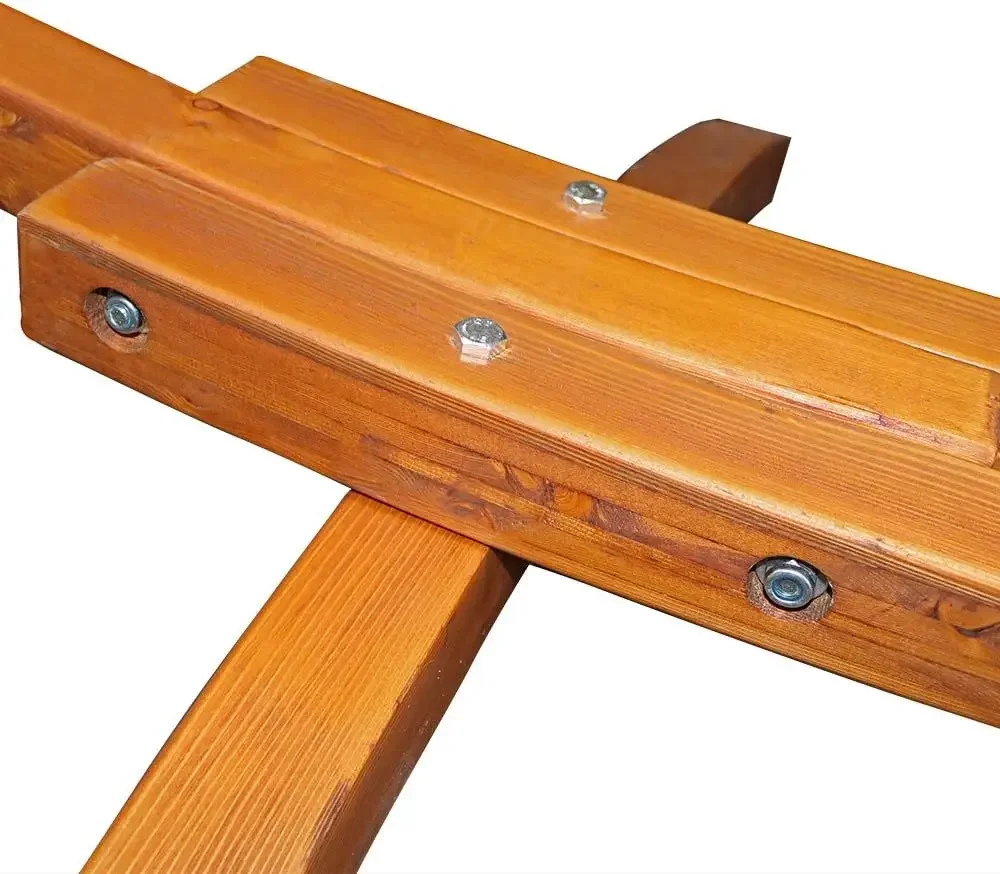
Popular design styles include classic wooden arc frames with sweeping curves, sleek contemporary metal frames with clean lines, and minimalist designs that blend into modern outdoor settings. The elevated design naturally draws the eye, creating an inviting relaxation destination in any space.
For those particularly interested in aesthetic impact, wooden arc stand hammock sets offer some of the most visually striking options, with graceful curves and warm natural materials that complement any outdoor décor.
A-Frame Stand Hammock Sets, Swinging Hammock Chair Sets
$154.62 Select options This product has multiple variants. The options may be chosen on the product pageClassic Wooden Stand Hammock Sets, Heavy Duty Hammock Sets
$1,061.68 Select options This product has multiple variants. The options may be chosen on the product pageHammock Sets with Canopy, Heavy Duty Hammock Sets
$286.31 Select options This product has multiple variants. The options may be chosen on the product pageDouble / Two Person Hammock Sets, Rope Hammock Sets
Double Traditional Cotton Rope Hammock with Extension Chains – 450 lbs Capacity for Backyard & Patio$292.98 Select options This product has multiple variants. The options may be chosen on the product pageHeavy Duty Hammock Sets, Wooden Arc Stand Hammock Sets
$878.66 Select options This product has multiple variants. The options may be chosen on the product page
Frame Materials and Designs: Choosing What’s Right for You
The frame of your spreader bar hammock significantly impacts its appearance, durability, and maintenance requirements. Understanding the characteristics of different materials helps you select the perfect option for your specific needs.
Wooden Frames
Wooden frames provide natural beauty and classic appeal, with these distinguishing features:
– Typically crafted from treated hardwoods like cypress, oak, or larch
– Require periodic sealing or staining to maintain weather resistance
– Offer exceptional stability due to their substantial weight
– Create a warm, organic aesthetic that blends with natural surroundings
– Generally support 400-450 pounds (181-204 kg)
Metal Frames
Metal frames offer modern styling and minimal maintenance:
– Usually constructed from powder-coated steel or aluminum
– Require minimal maintenance beyond occasional cleaning
– Provide excellent durability against weather exposure
– Often feature sleeker, more contemporary designs
– Typically support 450-500 pounds (204-227 kg)
Key Selection Factors
When choosing between frame options, consider:
– Weight capacity needs: Will multiple people use it simultaneously?
– Available space: Most frames require a footprint of approximately 14 × 4.5 feet (4.3 × 1.4 meters)
– Assembly complexity: Wooden frames often have fewer pieces but heavier components
– Maintenance willingness: How much ongoing care are you prepared to provide?
– Visual preference: Which style complements your existing outdoor décor?
Learning about materials used in spreader bar hammocks can provide deeper insight into how different options affect performance and longevity.
Comparing Hammock Styles: How Framed Spreader Bar Hammocks Stack Up
To truly appreciate the advantages of framed spreader bar hammocks, it’s helpful to compare them directly with other popular hammock styles.
| Feature | Framed Spreader Bar Hammock | Non-Framed Spreader Bar Hammock | Traditional Gathered-End Hammock |
|---|---|---|---|
| Stability | Excellent – self-supporting | Fair – requires proper tensioning | Good – wraps around user |
| Entry/Exit | Very easy – rigid structure | Moderate – can tip if unbalanced | Challenging – requires technique |
| Comfort Style | Flat, bed-like surface | Flat but can flip | Enveloping, cocoon-like |
| Setup Requirements | One-time assembly, no installation | Requires trees/posts/hardware | Requires trees/posts/hardware |
| Portability | Limited – heavy but movable | Good – can be taken down | Excellent – lightweight, packable |
| Space Requirements | Large dedicated footprint | Moderate – needs anchor points | Moderate – needs anchor points |
Framed spreader bar hammocks excel in situations where:
– Permanent or semi-permanent relaxation spaces are desired
– Trees or mounting points aren’t available
– Multiple users of varying experience will use the hammock
– Ease of entry and exit is a priority
– A furniture-like appearance is preferred
Different hammock and stand combinations offer varying benefits, allowing you to choose the style that best aligns with your specific relaxation preferences and situational needs.
Smart Shopping Guide: Essential Factors to Consider Before Purchase
Before investing in a framed spreader bar hammock, consider these key factors to ensure you select the option that best meets your needs:
Space Requirements
- Measure your intended location carefully – most frames require 12-15 feet (3.7-4.6 meters) of length
- Allow for at least 2 feet (0.6 meters) of clearance around all sides for safe entry and exit
- Consider height clearance for arched designs – typically 6-7 feet (1.8-2.1 meters) at the highest point
Intended Use
- Solo lounging: Standard width (40-50 inches/101-127 cm) is sufficient
- Sharing with a partner: Look for extra-wide models (55-60 inches/140-152 cm)
- Sunbathing: Consider models with adjustable canopies or shade features
Fabric Options
- Cotton: Offers excellent breathability and softness, but requires more maintenance
- Polyester: Provides superior weather resistance and color retention
- Quilted fabrics: Add padding and insulation for extended season use
- Rope variations: Create a traditional look with excellent ventilation
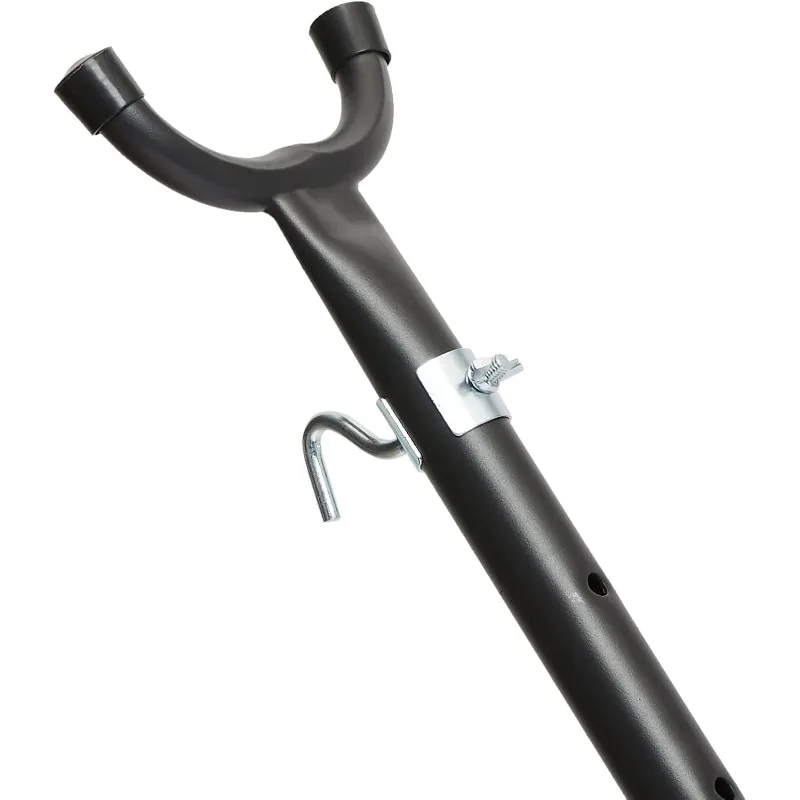
Critical Specifications
- Verify weight capacity for both hammock and stand (look for at least 275-300 pounds/125-136 kg)
- Check assembly complexity and tool requirements
- Consider available accessories (weather covers, cup holders, side tables)
For those requiring additional support, heavy-duty hammock sets provide reinforced frames and higher weight capacities without sacrificing comfort or style.
Maximizing Your Hammock’s Lifespan: Essential Care and Maintenance
With proper care, your framed spreader bar hammock will provide many seasons of relaxation. Follow these maintenance best practices to protect your investment:
Setup and Positioning
- Place on level ground to prevent frame stress and ensure stability
- Use on grass, decking, or add rubber feet for hard surfaces like concrete
- Avoid placing directly under trees that drop sap or excessive debris
Cleaning and Protection
- Clean fabric according to manufacturer recommendations (typically mild soap and water)
- Remove debris regularly to prevent staining and mildew growth
- Apply appropriate protectants to wooden frames annually (marine-grade sealant)
- Touch up any scratches in metal frames to prevent corrosion
Seasonal Care
- Store fabric indoors during extended periods of non-use
- Consider a weather-resistant cover if the frame will remain outdoors year-round
- Inspect all hardware, joints, and connection points before each season
Warning Signs
- Loose or creaking joints indicate the need for tightening
- Fraying around spreader bars suggests fabric stress
- Rusting hardware should be replaced promptly
Understanding proper hammock installation requirements and safety ensures your framed hammock remains safe and comfortable throughout its lifespan.
Are Framed Spreader Bar Hammocks Right for You? Final Considerations
Framed spreader bar hammocks represent a premium relaxation option that offers distinct advantages for certain users and situations. They’re particularly well-suited for:
- Those who value stability and ease of use over portability
- People creating permanent outdoor relaxation spaces
- Users who prefer a flat lying surface rather than the enveloping feel of traditional hammocks
- Situations where trees or mounting points aren’t available
- Outdoor spaces where aesthetic appeal is a priority
While the initial investment is higher than basic hammock options, the combination of durability, convenience, and comfort creates exceptional long-term value. Many users find that a quality framed hammock lasts through multiple seasons of outdoor enjoyment, making it more economical than repeatedly replacing less durable alternatives.
Understanding the features of framed hammocks with spreader bars can help you determine if this premium relaxation option aligns with your specific needs and preferences.
Common Questions About Framed Spreader Bar Hammocks
Can framed hammocks be left outdoors year-round?
While the frames are typically weather-resistant, most manufacturers recommend bringing the fabric indoors during extended periods of non-use to prevent unnecessary wear. For wooden frames, annual application of sealant helps maintain their integrity.
Can I purchase the frame and hammock separately?
Yes, many manufacturers offer compatibility between different frames and hammock beds, allowing you to customize your combination or replace components individually.
What’s the typical weight capacity?
Quality framed hammocks generally support between 300-500 pounds (136-227 kg), depending on the materials and construction. Always verify the specifications for your specific model.
How difficult is assembly?
Most models require basic tools and approximately 30 minutes for initial setup. Instructions are typically straightforward, with major components pre-assembled.
Will my hammock be stable on uneven ground?
For optimal safety and comfort, framed hammocks should be placed on relatively level surfaces. Minor unevenness can be accommodated, but significant slopes should be avoided.
How do I know if I have enough space?
Measure your intended area carefully and compare it to the product specifications. Most framed hammocks require approximately 12-15 feet (3.7-4.6 meters) of length and 4-5 feet (1.2-1.5 meters) of width.
Finding the perfect hammock placement for your home and garden helps ensure you select a hammock that fits your space while maximizing your relaxation potential.

